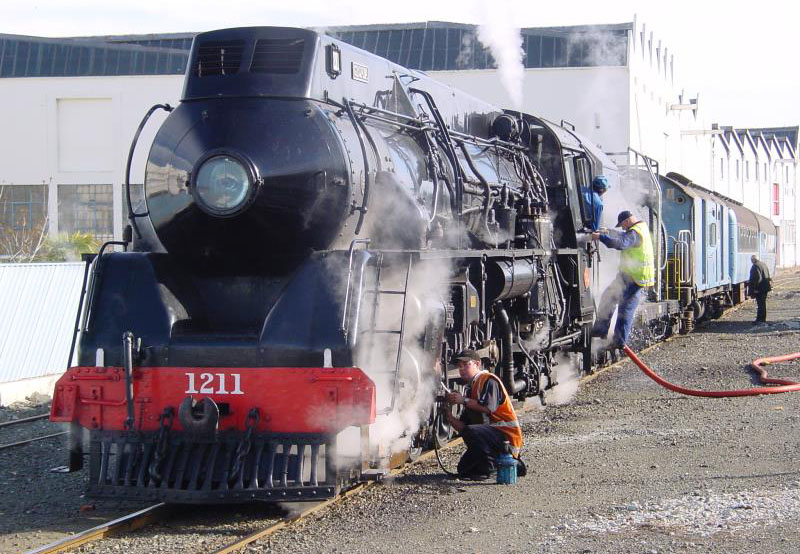|
Keretapi Tanah Melayu
Keretapi Tanah Melayu Berhad (KTMB) (; Jawi: ) or colloquially referred to simply as KTM, is the main rail operator in Peninsular Malaysia. The railway system dates back to the British colonial era, when it was first built to transport tin. Previously known as the Federated Malay States Railways (FMSR), the Malayan Railway Administration (MRA), and the Malayan Railway, Keretapi Tanah Melayu acquired its current name in 1962. The organisation was corporatised in 1992, but remains wholly owned by the Malaysian government. History In 1948, the FMSR was renamed the Malayan Railway. The railways had been devastated by the Japanese invasion of Malaya, and efforts were taken to rebuild the two main lines, but many branch lines were abandoned in the process. The MR began to modernize the equipment with the ordering of diesel locomotives and railcars to replace steam-hauled services, and the first diesel locomotive entered service in 1957. The railcars entered service in 1960, i ... [...More Info...] [...Related Items...] OR: [Wikipedia] [Google] [Baidu] |
Overhead Line
An overhead line or overhead wire is an electrical cable that is used to transmit electrical energy to electric locomotives, Electric multiple unit, electric multiple units, trolleybuses or trams. The generic term used by the International Union of Railways for the technology is ''overhead line''. It is known variously as overhead catenary, overhead contact line (OCL), overhead contact system (OCS), overhead equipment (OHE), overhead line equipment (OLE or OHLE), overhead lines (OHL), overhead wiring (OHW), traction wire, and trolley wire. An overhead line consists of one or more wires (or Overhead conductor rail, rails, particularly in tunnels) situated over rail tracks, raised to a high electrical potential by connection to feeder stations at regularly spaced intervals along the track. The feeder stations are usually fed from a High voltage, high-voltage Electricity distribution, electrical grid. Overview Electric trains that collect their current from overhead lines use a de ... [...More Info...] [...Related Items...] OR: [Wikipedia] [Google] [Baidu] |
KTM West Coast Railway Line
The KTM West Coast railway line is a main railway line in Malaysia. It runs from close to the Malaysia–Thailand border in Perlis (where it connects with the State Railway of Thailand) to the Woodlands Train Checkpoint in Singapore. Running near parallel to the West Coast and serving the West Coast states of Peninsular Malaysia. The line is owned and used entirely by Keretapi Tanah Melayu (KTM). Past , the line continues on to become the Thai Southern Line (Thailand), Southern Line, which continues up towards Hat Yai and Bangkok. The 1,151-kilometre line is busier than its east coast counterpart, the KTM East Coast Line, East Coast railway line since it is double tracked and electrified for most of its route and has more services. The line handles a variety of passenger train services such as KTM ETS services, KTM Intercity services, State Railway of Thailand International Express services, KTM Komuter services within the Klang Valley and the George Town Conurbation, and freigh ... [...More Info...] [...Related Items...] OR: [Wikipedia] [Google] [Baidu] |
Brush HMA
Brush HMA is a manufacturer of large generators for gas turbine and steam turbine drive applications, based at Ridderkerk in the Netherlands. History The business began back in November 1882 when two young Dutch entrepreneurs, Adriaan Pot and Willem Smit established a company called Elektrisch Licht-Machinen Fabriek Willem Smit & Co.. Later, the name changed to Smit Slikkerveer. In the early days, the company manufactured various electrical products including dynamos and lighting equipment. This was followed by direct current (DC) and alternating current (AC) electric motors, generators, drives and transformers. In 1962, following a merger between Smit Slikkerveer and the dominant Heemaf Hengelo along with several other companies, the new name of Samenwerkende Elektrotechische Fabrieken Holec N.V. was created. During the 1980s, the company, which was simply known as Holec Machines and Apparaten (''HOLEC''), was suffering from failing business due to downturns and changes in old i ... [...More Info...] [...Related Items...] OR: [Wikipedia] [Google] [Baidu] |
KTM Class 18 Shunter
KTM is an Austrian motorcycle, bicycle and motorsports brand that is majority-owned by Indian manufacturer Bajaj Auto and Austrian manufacturer Pierer Mobility AG. It traces its foundation to 1934 as Kronreif & Trunkenpolz Mattighofen. Today, Pierer Mobility AG operates as the manufacturer of KTM branded motorcycles, and KTM Fahrrad AG operates as the manufacturer of KTM branded bicycles. KTM is known for its off-road motorcycles (enduro, motocross and supermoto). Since the late 1990s, it has expanded into street motorcycle production and developing sports cars – namely the X-Bow. In 2015, KTM sold almost as many street as off-road bikes. History Early years In 1934, Austrian engineer Johann (Hans) Trunkenpolz (1909–1962) set up a fitter's and car repair shop in Mattighofen. In 1937, he started selling DKW motorcycles, and Opel cars the following year. His shop was known as ''Kraftfahrzeug Trunkenpolz Mattighofen'', but the name was unregistered. During the Secon ... [...More Info...] [...Related Items...] OR: [Wikipedia] [Google] [Baidu] |
Kisha Seizo
was a Japanese manufacturer of railway rolling stock that existed from 1896 to 1972. * 1896: Established by Inoue_Masaru_(bureaucrat), Masaru Inoue as the . * 1899: Factory opened in Osaka. * 1901: Merged with the , a coach and car maker in Tokyo. The two plants were reorganized as the Osaka Head Office and the Tokyo Branch. * 1912: Becomes after corporate restructuring. * 1936: Head office moved to Tokyo; Osaka Head Office becomes Osaka Branch. * 1944: The two branches (factories) renamed Osaka Works and Tokyo Works respectively. * 1968: Construction of railway wagon factory in Utsunomiya. * 1972: Merged with Kawasaki Heavy Industries. Preserved Kisha Seizō Locomotives Further reading References {{reflist Locomotive manufacturers of Japan Rolling stock manufacturers of Japan Defunct companies of Japan Japanese companies established in 1896 ... [...More Info...] [...Related Items...] OR: [Wikipedia] [Google] [Baidu] |
KTM Class 17
KTM is an Austrian motorcycle, bicycle and motorsports brand that is majority-owned by Indian manufacturer Bajaj Auto and Austrian manufacturer Pierer Mobility AG. It traces its foundation to 1934 as Kronreif & Trunkenpolz Mattighofen. Today, Pierer Mobility AG operates as the manufacturer of KTM branded motorcycles, and KTM Fahrrad AG operates as the manufacturer of KTM branded bicycles. KTM is known for its off-road motorcycles (enduro, motocross and supermoto). Since the late 1990s, it has expanded into street motorcycle production and developing sports cars – namely the X-Bow. In 2015, KTM sold almost as many street as off-road bikes. History Early years In 1934, Austrian engineer Johann (Hans) Trunkenpolz (1909–1962) set up a fitter's and car repair shop in Mattighofen. In 1937, he started selling DKW motorcycles, and Opel cars the following year. His shop was known as ''Kraftfahrzeug Trunkenpolz Mattighofen'', but the name was unregistered. During the Second ... [...More Info...] [...Related Items...] OR: [Wikipedia] [Google] [Baidu] |
North British Locomotive Company
The North British Locomotive Company (NBL, NB Loco or North British) was created in 1903 through the merger of three Glasgow locomotive manufacturing companies; Sharp, Stewart and Company (Atlas Works), Neilson, Reid and Company (Hyde Park Works) and Dübs and Company (Queens Park Works), creating the largest locomotive manufacturing company in Europe and the British Empire and the second largest in the world after the Baldwin Locomotive Works in the United States. Its main factories were located at the neighbouring Atlas and Hyde Park Works in central Springburn, as well as the Queens Park Works in Polmadie. A new central Administration and Drawing Office for the combined company was completed across the road from the Hyde Park Works on Flemington Street by James Miller (architect), James Miller in 1909, later sold to Glasgow Corporation in 1961 to become the main campus of North Glasgow College (now Glasgow Kelvin College). The two other Railway works in Springburn were St ... [...More Info...] [...Related Items...] OR: [Wikipedia] [Google] [Baidu] |
KTM Class 16
KTM is an Austrian motorcycle, bicycle and motorsports brand that is majority-owned by Indian manufacturer Bajaj Auto and Austrian manufacturer Pierer Mobility AG. It traces its foundation to 1934 as Kronreif & Trunkenpolz Mattighofen. Today, Pierer Mobility AG operates as the manufacturer of KTM branded motorcycles, and KTM Fahrrad AG operates as the manufacturer of KTM branded bicycles. KTM is known for its off-road motorcycles (enduro, motocross and supermoto). Since the late 1990s, it has expanded into street motorcycle production and developing sports cars – namely the X-Bow. In 2015, KTM sold almost as many street as off-road bikes. History Early years In 1934, Austrian engineer Johann (Hans) Trunkenpolz (1909–1962) set up a fitter's and car repair shop in Mattighofen. In 1937, he started selling DKW motorcycles, and Opel cars the following year. His shop was known as ''Kraftfahrzeug Trunkenpolz Mattighofen'', but the name was unregistered. During the Second ... [...More Info...] [...Related Items...] OR: [Wikipedia] [Google] [Baidu] |
English Electric
The English Electric Company Limited (EE) was a British industrial manufacturer formed after World War I by amalgamating five businesses which, during the war, made munitions, armaments and aeroplanes. It initially specialised in industrial electric motors and transformers, locomotives and railway electric traction, traction equipment, diesel engine, diesel motors and steam turbines. Its products were later expanded to include consumer electronics, nuclear reactors, guided missiles, military aircraft and mainframe computers. Two English Electric aircraft designs became landmarks in British aeronautical engineering; the English Electric Canberra, Canberra and the English Electric Lightning, Lightning. In 1960, English Electric Aircraft (40%) merged with Vickers Armstrongs, Vickers (40%) and Bristol Aeroplane Company, Bristol (20%) to form British Aircraft Corporation. In 1968 English Electric's operations were merged with General Electric Company#Further expansion (1961–83), ... [...More Info...] [...Related Items...] OR: [Wikipedia] [Google] [Baidu] |
KTM Class 15
KTM is an Austrian motorcycle, bicycle and motorsports brand that is majority-owned by Indian manufacturer Bajaj Auto and Austrian manufacturer Pierer Mobility AG. It traces its foundation to 1934 as Kronreif & Trunkenpolz Mattighofen. Today, Pierer Mobility AG operates as the manufacturer of KTM branded motorcycles, and KTM Fahrrad AG operates as the manufacturer of KTM branded bicycles. KTM is known for its Types of motorcycles#Off-road, off-road motorcycles (enduro, motocross and supermoto). Since the late 1990s, it has expanded into Types of motorcycles#Street, street motorcycle production and developing sports cars – namely the KTM X-Bow, X-Bow. In 2015, KTM sold almost as many street as off-road bikes. History Early years In 1934, Austrian engineer Johann (Hans) Trunkenpolz (1909–1962) set up a fitter's and car repair shop in Mattighofen. In 1937, he started selling DKW motorcycles, and Opel cars the following year. His shop was known as ''Kraftfahrzeug Trunken ... [...More Info...] [...Related Items...] OR: [Wikipedia] [Google] [Baidu] |
Track Gauge
In rail transport, track gauge is the distance between the two rails of a railway track. All vehicles on a rail network must have Wheelset (rail transport), wheelsets that are compatible with the track gauge. Since many different track gauges exist worldwide, gauge differences often present a barrier to wider operation on railway networks. The term derives from the metal bar, or gauge, that is used to ensure the distance between the rails is correct. Railways also deploy two other gauges to ensure compliance with a required standard. A ''loading gauge'' is a two-dimensional profile that encompasses a cross-section of the track, a rail vehicle and a maximum-sized load: all rail vehicles and their loads must be contained in the corresponding envelope. A ''structure gauge'' specifies the outline into which structures (bridges, platforms, lineside equipment etc.) must not encroach. Uses of the term The most common use of the term "track gauge" refers to the transverse distance be ... [...More Info...] [...Related Items...] OR: [Wikipedia] [Google] [Baidu] |










